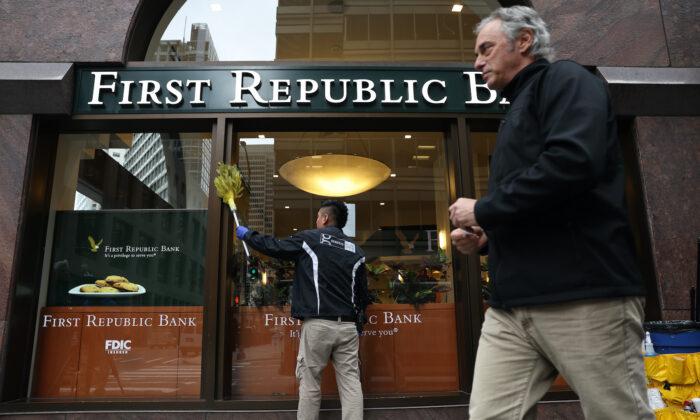President Joe Biden and JPMorgan Chase CEO Jamie Dimon reiterated that the worst of the crisis is over.
“These actions are going to make sure that the banking system is safe and sound, and that includes protecting small businesses across the country who need to make payroll for workers and their small businesses,” the president said at the White House on May 1 during an event celebrating National Small Business Week.
The First Republic Business Model
The California-based financial institution, which became the second-largest bank failure in U.S. history, mirrored the same business model as Silicon Valley Bank and Signature, offering preferential rates to appeal to high-income clients.Moreover, like SVB, its investment portfolio and loan book lost their value as the Federal Reserve launched its inflation-fighting quantitative tightening campaign and began raising interest rates. First Republic began accumulating paper losses, with gross unrealized losses in long-duration bonds soaring to $4.8 billion by December 2022, up from $53 million in the previous year.
Growing Deposits
JPMorgan Chase will assume First Republic’s deposit base, allowing all insured and uninsured clients to access their money. This means that America’s largest bank will have an additional $104 billion worth of deposits on the books. As a result, the institution’s deposits will be about $2.5 trillion, representing about 14 percent of the nation’s total deposits.
But how did JPMorgan circumvent the so-called deposit cap when acquiring First Republic? The bank avoided the rule on a technicality because it was acquiring the company in receivership and offered favorable terms to the Federal Deposit Insurance Corp. (FDIC).
FDIC Proposal
The FDIC published a 76-page report recommending raising the insured deposit limit for businesses on a “targeted basis.” This backstop would offer more protection for business accounts, flexibility for the agency, and certainty in the financial system currently facing many risks.“The recent failures of Silicon Valley Bank and Signature Bank, and the decision to approve Systemic Risk Exceptions to protect the uninsured depositors at those institutions, raised fundamental questions about the role of deposit insurance in the United States banking system,” FDIC Chairman Martin J. Gruenberg said in a May 1 statement.
Since the failures of SVB and Signature, there have been discussions to re-evaluate limits on federally insured bank deposits. Fed Chair Jerome Powell urged lawmakers in March to take another look at the deposit insurance program.

Is the Banking Sector Shrinking?
The White House was asked during the May 1 press briefing if Biden is concerned about JPMorgan becoming bigger after its acquisition of First Republic.“But more broadly, no recent administration has done more to promote competition, address concentration process across industries,” press secretary Karine Jean-Pierre told reporters. “We value the community bank model, which provides robust competition to larger banks and provide banking services to communities that might otherwise not get service.”
The White House refrained from clarifying what other banks submitted bids during the FDIC’s auction process. Reports had claimed that a dozen entities submitted bids, including PNC Financial Services Group.
With further consolidation in the financial sector, there has been a renewed spotlight on the shrinking number of U.S. banks.
“It increases the ability of JPMorgan to wipe them out,” he said. “It is very good for JPMorgan, maybe a lot less good for American banking.”





